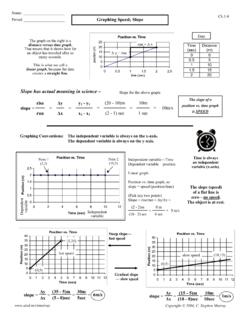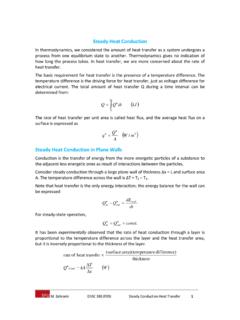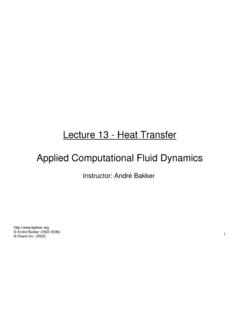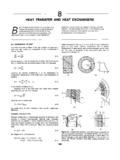Transcription of Thermal energy (heat) is transferred in three ways ...
1 Ch. 27:1 Name: _____ Period: _____ Copyright 2004, C. Stephen Murray Thermodynamics Thermodynamics is the study of how heat moves. heat always transfers from hot to cold. heat does not rise (hot air rises). 25oC 5oC heat transfer Conduction Conduction transfers heat through objects touching. Insulators slow down heat transfer. Materials with air pockets are good insulators. 25oC 5oC slow transfer wood Conductors easily allow heat transfer. Most metals are good conductors. 25oC 5oC fast transfer metal Thermal energy ( heat ) is transferred in three ways: Conduction; Convection; Radiation. Hot atom Cold atom Conduction transfers heat by atoms colliding and transferring energy . 25oC 5oC conduction All atoms are vibrating (moving), which means they have kinetic energy . Hot atoms have more Ek. When hot atoms bump into cold atoms they transfer some energy . Closer atoms mean more colli-sions.
2 So solids tend to transfer heat better than liquids or gases. Gases tend to make good insula-tors. Sometimes, though a liquid (water) can speed up conduction with an insulator (your skin). Solid Liquid Gas High density Low density Better conductors Better insulators Radiation Radiation transfers heat through electromagnetic radiation; occurs even in a vacuum (empty space). Radiation transfers heat through electromagnetic waves pure Thermal energy . Radiation transfers heat in all directions even down. Convection currents always rise. Radiation requires no contact convection and conduction require touching. Radiation can go through transparent materials (barriers) like glass. All energy on earth comes originally from the sun. Space is a vacuum (no matter at all). So only radiation can travel through space to the earth. Dark objects absorb more radiation than light objects.
3 Dull objects absorb more radiation than shiny objects. heat transfer continues until both objects are at Thermal equilibrium: the same temperature. High absorption of radiation. Heats fast. Low absorption of radiation. Heats slowly. Convection transfers heat through moving currents in gases or liquids. heat Source Hot Liquid Rises Hot liquids (and gases) are less dense and rise, causing convection currents. These currents transfer heat throughout the liquid (or gas). Gases transfer heat poorly through conduction. Convection currents speed up Thermal transfer. Convection currents can only happens in gases (like air) or liquids (like water), not in solids because solids can t move. Hot air rises Cold air is pulled in causing wind. wind Much of the weather on earth comes from convection currents. The sun warms air at the surface of the earth. Warm air rises, causing winds.
4 When the air cools it falls back to the ground. Convection No currents No convection Ch. 27:1 Name: _____ Period: _____ Copyright 2004, C. Stephen Murray 1. Conduction 2. Thermal Equilibrium 3. Radiation 4. Wind 5. Convection 6. Thermodynam-ics A. heat transfer through electromagnetic waves. B. Thermal ( heat ) transfer by the contact (touching) of two objects. C. Transfers heat by moving currents in gases and liquids. D. When two objects are at the same tem-perature. E. The study of how heat moves. F. Caused by convection currents in the earth s atmosphere. 1. Insulator 2. Conductor 3. Vacuum 4. Solid 5. Liquid 6. Gas A. A region of space that contains no matter. B. Allows convection, but is a very good insulator. C. Any material that easily allows heat to move through it. D. Allows convection; can be a good conductor of heat . E. Any material that resists the movement of heat through it.
5 F. No convection can occur in this. Which of the following are at Thermal equilibrium? 25oC 5oC 5oC 25oC 5oC 5oC 25oC 25oC ____ When hot air rises. ____ When two objects are touching. ____ When nothing is touching. ____ When atoms collide. ____ Transfers heat in all directions. ____ Causes wind. ____ Between a stove and a pot. ____ Within a pan of water. ____ More occurs with dark objects. ____ Through a car s windows at night. What Kind of Thermal Transfer? 1. Conduction; 2. Convection; 3. Radiation A. B. C. D. Thermal Insulator or Thermal Conductor? ____ Metal ____ Wood ____ Air ___ Glass ___ A penny ___ Water ___ A coat ___ Styrofoam ___ Aluminum Draw an arrow for each of the following pair of objects showing the direction of the Thermal transfer. 10oC 25oC 10oC 25oC 25oC 15oC 40oC 25oC Absorbs heat (heats fast) or Reflects heat (heats slowly)? ____ Dark liquids ____ Clear liquids ____ Shiny objects ____ Dull objects ____ White paper ____ Black paper ___ Aluminum ___ Styrofoam ___ Dark car Does heat rise?
6 Does hot air rise? Why? Is this diagram correct or incorrect and why? 25oK 15oK heat transfer



